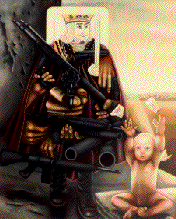



|
Michael S. Bell, a specialist in American Art, researched the surrealist phenomena while he was Curatorial Assistant at the Museum of Modern Art in San Francisco fifteen years ago. He came to the conclusion that two very distinct trends of surrealism had developed. One could be qualified as Automatism, and the other as Veristic Surrealism.
"Automatism," explains Mr. Bell, "is a form of abstraction. It has been the only one accepted by critical reviewers after the war. Chief among the Automatists were Miro, Arp, Duchamp, Masson, Matta. It is easy to then find a bridge between these artists and the works of Pollock and de Kooning. Automatism was the source of action painting, Abstract expressionism, and all that followed. Legions of followers came along later, and most of the art world has been consumed by this branch since World War II. Veristic Surrealism is a form of representational academic art, whose intent is to deal with the inner, subjective instead of the outer, objective world. Dali, de Chirico, Magritte, Delvaux, Remedios Varo and Carrington belong to this trend, which is what is considered Surrealism today.
Some of the features revealed in Mr. Bell's investigation are: "The group of surrealists is far larger and more diverse than either current criticism or theory embraces...Veristic Surrealism got thrown out with pre-impressionistic academic art without much second thought, and is still in danger of that fate...Fortunately, the artists themselves dictate what is finally important in art, and the surrealists have demonstrated high courage to simply continue working as they do...They have suffered a form of bigotry and exclusion that closely parallels other forms of socio-economic oppression in history."
Mr. Bell compiled a library of Veristic Surrealism with more than twelve hundred artists working in this style who are originally from, or live in the United States. Three main families were recognized by Mr. Bell as emerging from Veristic Surrealism:
1) Classical Surrealism takes the dream images of the unconscious, letting them flow on the canvas without interpretation or judgment, thereby permitting everything to coexist as in a dream.
2) Social Surrealism works with symbolic images representing the inner visions of the workings of man within the context of the collective unconscious.
 |
| The Eternal Herod, By Mariu Suarez, 60"x78" Oil and egg-tempera on canvas |
3) Visionary Surrealism expresses all that is positive in the human experience, and the intuitive awareness of a Supraconsciousness as the directive Mind behind subconsciousness and consciousness.
 |
| Daughter of the Voice, By Mariu Suarez, 60"x46" Oil and egg-tempera on canvas |
Because it was rejected by the new academy of modernism, Veristic Surrealism in its evolution has suddenly become a new art. A new art that, in the words of Donald Kuspit, "Must first show that it has democratic appeal–appeal to those generally unschooled in art or not professionally interested in it. Then it must suffer a period of aristocratic rejection–by those schooled in an accepted and thereby 'traditional' art, those with a vested interest in a known art, and concerned with protecting it at all cost".
This page is maintained by Monica Sanchez. Your comments are welcomed.